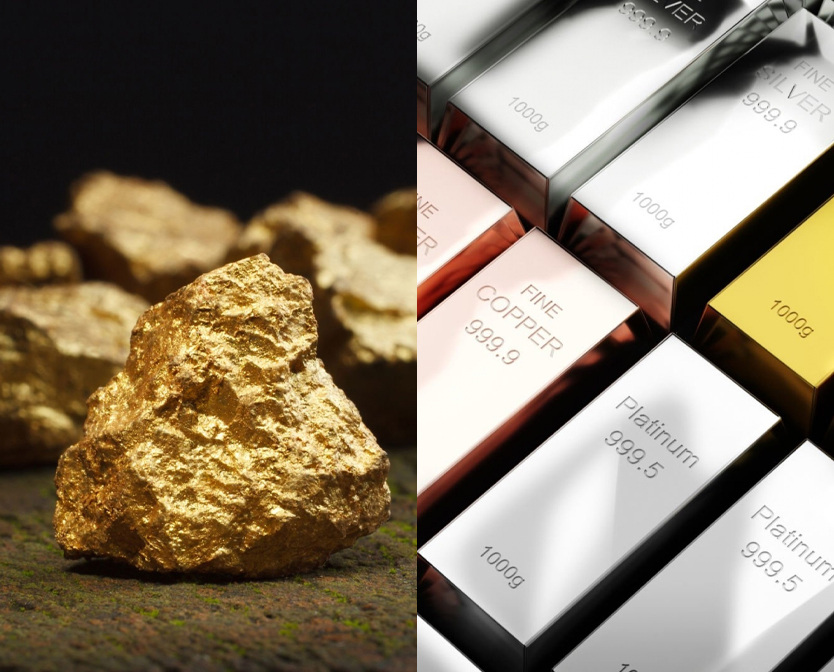Discover the differences between white gold, yellow gold, and platinum, and their unique qualities in jewelry.
Buying diamond jewelry online can be tough and frustrating since you can't physically see or touch the piece.
Investing in precious metals like gold, silver, platinum, or palladium can diversify and hedge against inflation in high economic uncertainty. Options include bullion coins, exchange traded funds etfs, mining shares, or mutual funds depending on their risk tolerance and investment purposes. Before investing in precious metals investment, it's important to think about storage, expenses, and market conditions. Make sure it fits with your financial plan before adding it to your investment portfolio.
Gold
Gold is a valuable metal that has represented affluence since time immemorial. Pure gold, in its most expensive form of 24 karats, is very soft.
To make it stronger and more durable, people often mix gold bar with silver coin and copper. We call this process alloying. Lowering physical gold's value slightly, this process also strengthens it, making it ideal for creating long-lasting, high-quality jewelry.
Purity
A number followed by "k" shows the purity of the gold and indicates the amount of gold in the jewelry. Express karatage in 24ths to make 24k gold, which is 100% gold.
We make our jewelry with 18k and 14k gold, mixed with other metals to make it durable for daily use.
18-karat gold consists of 75% pure gold and 25% other metals (in an 18/24 ratio). They stamp jewelry of this quality with "18k." In Europe, they label it as "750," indicating it contains 75 percent gold.
14-karat gold consists of 58.5% pure gold and 41.5% other metals, following a 14/24 proportion. They mark jewelry of this fineness as "14k." The European label "585" signifies that the gold content is 58.5 percent.
14k gold has a less rich gold color compared to 18k gold. This is because it contains 58.5% gold and 41.5% other metals for strength.
Color
The kind of metal alloys incorporated and their respective proportions dictate the color of gold.
- Yellow Gold
Gold's inherent color is yellow, but the alloys are what provide the gold with a more intense and lustrous sheen. This precious metal commodity gets its distinctive warmth from a unique mix of copper, silver, and pure gold.
- White Gold
The silvery white nature of white gold jewelry is what makes it so attractive. Mix pure gold with other metals like zinc, copper, palladium, and sometimes tin or nickel to make white gold. 18k white gold contains 75% gold, while 14k white gold contains 58.5% gold. As a result, jewelry made from these materials may have a slight yellow tint.
Jewelers coat most white gold with rhodium to make it brighter. Rhodium is a strong, shiny, white metal. As jewelry gets older, the rhodium plating can wear away, showing the metal color underneath. You can easily restore your jewelry's whiteness by re-plating it if needed.
- Rose Gold
Rose gold jewelry gets its beautiful pink color from a copper alloy. The metal alloys in it are the same as yellow or white gold, but they are mixed differently.
- Green Gold
Mix silver, copper, and zinc to create this alloy into yellow gold.
Cost
Gold is expensive because it is rare and in high demand. The price of gold is determined by its quality. The amount of pure gold it contains specifically measures this quality. The price of gold is also influenced by the other valuable metals price.
The design and craftsmanship of jewelry also affect its gold price. Typically, a meticulously handcrafted item will cost more than its mass-produced counterpart.
Maintenance
Harmful chemicals like chlorine or other cleaning agents can damage gold, given its natural composition. We advise you to take off your jewelry when handling chemicals to minimize daily wear and tear and maintain its shine. For cleaning gold coin, use a mixture of warm water and soap without detergent, along with a soft-bristled brush. Keep your gold pieces safe by storing them in cloth bags or the original box when not being worn.
At JavdaJewelry, we provide an exquisitely designed jewelry box to safeguard, maintain, and arrange your treasured possessions.
Platinum
Platinum is a precious metal are rare scarce, hence its high value. The global annual production of platinum is only 10-20% of that of gold. Its most attractive features are its durability and stunning beauty.
Unlike other metals, platinum does not lose any material when scratched and it does not erode over time. For jewelry purposes, platinum is typically 95% pure, with the remaining 5% consisting of palladium, ruthenium, or other alloys. To ensure the quality of platinum, manufacturers mark it with Plat, PT, 950 Plat, or 950 Pt.
Platinum doesn't often cause allergies and doesn't tarnish because it's denser than other metals like gold, silver, platinum and palladium. Nonetheless, it is prone to scratches and might acquire a patina over time.
At JavdaJewelry, we take pride in providing an extensive range of platinum settings for our premium jewelry items. Our platinum consists of a minimum of 95% pure platinum, with up to 5% of alloy metals incorporated.
Cost
Its purity, quantity, market price, craftsmanship, and design determine the silver price fluctuations of platinum jewelry. Platinum rings are typically priced at 2-4 times higher than 18-karat gold rings. Platinum rings are usually 2-4 times more expensive than 18-karat gold rings.
Maintenance
Daily use of platinum may result in a subtle gloss. While many individuals find this appealing, you can always get a jeweler to buff it and bring back its initial luster. To keep platinum jewelry looking good, just soak it in soapy water, scrub gently with a soft brush. To protect your jewelry, store it in its original box, a soft bag, or a fabric-lined jewelry box.







